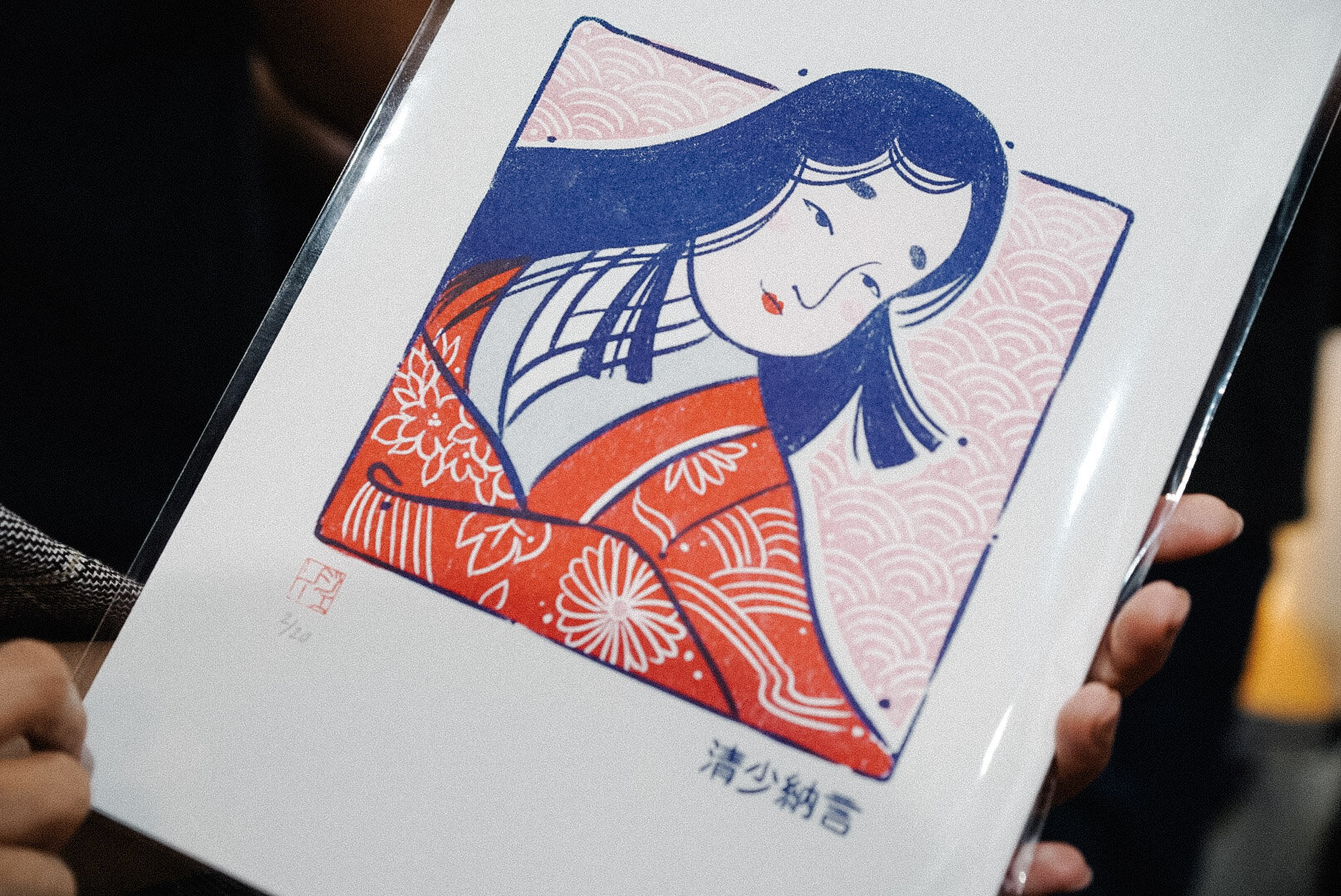 Image 1 of 5
Image 1 of 5

 Image 2 of 5
Image 2 of 5

 Image 3 of 5
Image 3 of 5

 Image 4 of 5
Image 4 of 5

 Image 5 of 5
Image 5 of 5






Kobayashi Haru 小林ハル - A4 Riso Print (Signed and Numbered)
Kobayashi Haru 小林ハル
The last blind shamisen player
日本史上最後の瞽女(盲人女性芸能者) (1900年1月24日–2005年4月25日)
瞽女は組織が売春組織であるという印象を与えないよう、またはよそで収入を得ないようにするために結婚することを禁止されるというルールを課されていました。
Kobayashi Haru was a Japanese musician who sang ‘goze’ songs accompanied by shamisen. In the Edo period, goze organisations formed that allowed blind women to gain financial independence through playing music. However, goze rules still restricted women to be celibate to avoid the impression of the organisation being a prostitution ring, or to prevent a woman from marrying and gaining a secondary source of income.
Kobayashi had been blind since the age of three months. She was raised by a foster family who feared the stigma of disability discrimination, and so forced her to live in her bedroom to avoid being discovered by neighbours. During shamisen training at age five, her mother threatened to drown her if she complained of her fingers hurting. When she was allowed to go out to perform at age eight, she learned of her blindness through meeting girls of her own age.
Kobayashi was habitually abused by her mentor and eventually, he cancelled her apprenticeship in 1915. In the same year, she entered into a new apprenticeship who praised her, treated with her with fairness and helped her reach her full potential. She went on to perform around Niigata and neighbouring prefectures until 1978 when she was named as one of the Living National Treasures of Japan.
What is a riso print?
These prints use risograph technology, a method of printing developed in Japan in the mid-1980s. It can be described as a mix between screenprinting and photocopying. The risograph process produces prints with extremely vibrant, crisp inks, and sometimes these inks overlap during the printing process to create interesting and unique details. These soy-based inks also have a lower environmental impact.
Product details
Printed in Tokyo, Japan by Hand Saw Press print studio. Each print is A4 size (210 x 297 mm / 8.27 x 11.69 in) and printed on Natural White 186gsm Takeo Araveal paper. Acid-free and FSC Approved.
Each print is signed with a traditional Japanese ‘hanko’ artist stamp and hand-numbered from a limited edition of 20. Prints are packaged in cello bags with rigid cardboard inserts and shipped in flat mailers.
Please note that frames are not included.
Delivery times & prices
We ship worldwide. 日本へ国際郵便で送ります。
UK deliveries: 3-4 working days via Royal Mail 1st class
International deliveries available via Royal Mail International Standard Airmail
Prices calculated during checkout
For more information on shipping times for international deliveries, please check the delivery & returns page.
Kobayashi Haru 小林ハル
The last blind shamisen player
日本史上最後の瞽女(盲人女性芸能者) (1900年1月24日–2005年4月25日)
瞽女は組織が売春組織であるという印象を与えないよう、またはよそで収入を得ないようにするために結婚することを禁止されるというルールを課されていました。
Kobayashi Haru was a Japanese musician who sang ‘goze’ songs accompanied by shamisen. In the Edo period, goze organisations formed that allowed blind women to gain financial independence through playing music. However, goze rules still restricted women to be celibate to avoid the impression of the organisation being a prostitution ring, or to prevent a woman from marrying and gaining a secondary source of income.
Kobayashi had been blind since the age of three months. She was raised by a foster family who feared the stigma of disability discrimination, and so forced her to live in her bedroom to avoid being discovered by neighbours. During shamisen training at age five, her mother threatened to drown her if she complained of her fingers hurting. When she was allowed to go out to perform at age eight, she learned of her blindness through meeting girls of her own age.
Kobayashi was habitually abused by her mentor and eventually, he cancelled her apprenticeship in 1915. In the same year, she entered into a new apprenticeship who praised her, treated with her with fairness and helped her reach her full potential. She went on to perform around Niigata and neighbouring prefectures until 1978 when she was named as one of the Living National Treasures of Japan.
What is a riso print?
These prints use risograph technology, a method of printing developed in Japan in the mid-1980s. It can be described as a mix between screenprinting and photocopying. The risograph process produces prints with extremely vibrant, crisp inks, and sometimes these inks overlap during the printing process to create interesting and unique details. These soy-based inks also have a lower environmental impact.
Product details
Printed in Tokyo, Japan by Hand Saw Press print studio. Each print is A4 size (210 x 297 mm / 8.27 x 11.69 in) and printed on Natural White 186gsm Takeo Araveal paper. Acid-free and FSC Approved.
Each print is signed with a traditional Japanese ‘hanko’ artist stamp and hand-numbered from a limited edition of 20. Prints are packaged in cello bags with rigid cardboard inserts and shipped in flat mailers.
Please note that frames are not included.
Delivery times & prices
We ship worldwide. 日本へ国際郵便で送ります。
UK deliveries: 3-4 working days via Royal Mail 1st class
International deliveries available via Royal Mail International Standard Airmail
Prices calculated during checkout
For more information on shipping times for international deliveries, please check the delivery & returns page.
Kobayashi Haru 小林ハル
The last blind shamisen player
日本史上最後の瞽女(盲人女性芸能者) (1900年1月24日–2005年4月25日)
瞽女は組織が売春組織であるという印象を与えないよう、またはよそで収入を得ないようにするために結婚することを禁止されるというルールを課されていました。
Kobayashi Haru was a Japanese musician who sang ‘goze’ songs accompanied by shamisen. In the Edo period, goze organisations formed that allowed blind women to gain financial independence through playing music. However, goze rules still restricted women to be celibate to avoid the impression of the organisation being a prostitution ring, or to prevent a woman from marrying and gaining a secondary source of income.
Kobayashi had been blind since the age of three months. She was raised by a foster family who feared the stigma of disability discrimination, and so forced her to live in her bedroom to avoid being discovered by neighbours. During shamisen training at age five, her mother threatened to drown her if she complained of her fingers hurting. When she was allowed to go out to perform at age eight, she learned of her blindness through meeting girls of her own age.
Kobayashi was habitually abused by her mentor and eventually, he cancelled her apprenticeship in 1915. In the same year, she entered into a new apprenticeship who praised her, treated with her with fairness and helped her reach her full potential. She went on to perform around Niigata and neighbouring prefectures until 1978 when she was named as one of the Living National Treasures of Japan.
What is a riso print?
These prints use risograph technology, a method of printing developed in Japan in the mid-1980s. It can be described as a mix between screenprinting and photocopying. The risograph process produces prints with extremely vibrant, crisp inks, and sometimes these inks overlap during the printing process to create interesting and unique details. These soy-based inks also have a lower environmental impact.
Product details
Printed in Tokyo, Japan by Hand Saw Press print studio. Each print is A4 size (210 x 297 mm / 8.27 x 11.69 in) and printed on Natural White 186gsm Takeo Araveal paper. Acid-free and FSC Approved.
Each print is signed with a traditional Japanese ‘hanko’ artist stamp and hand-numbered from a limited edition of 20. Prints are packaged in cello bags with rigid cardboard inserts and shipped in flat mailers.
Please note that frames are not included.
Delivery times & prices
We ship worldwide. 日本へ国際郵便で送ります。
UK deliveries: 3-4 working days via Royal Mail 1st class
International deliveries available via Royal Mail International Standard Airmail
Prices calculated during checkout
For more information on shipping times for international deliveries, please check the delivery & returns page.




